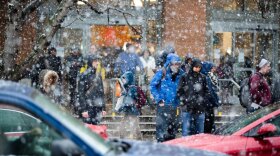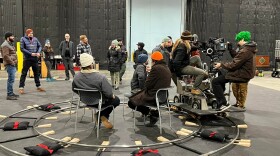This year marks the 25th anniversary for the Museum of Pop Culture, or MoPOP. Back then, it was called the Experience Music Project, and opened with a huge rock and roll event covered by MTV.
The one-of-a-kind, colorful building, designed by Frank Gehry and dedicated to modern music, was a passion project of the late Microsoft co-founder Paul Allen. One of the features inside the building that has remained popular is the Sound Lab. It's designed to teach people with no experience how to sing and play musical instruments, like the drums and guitar.
KNKX talked with Andrea Weatherhead, who led the design team that created the interactive exhibit.

Interview Highlights
On the museum's expansion from its Jimi Hendrix roots
Just before I arrived on the scene, they had been contemplating making it just a Jimi Hendrix museum, because Paul Allen had a very extensive collection of artifacts from Jimi Hendrix. But his sister — who was very much plugged into cultural centers and what could make something successful as an arts place for the public — felt that he should expand that mission to kind of be about American popular music at large, and celebrating creativity, innovation, through the medium of contemporary American music. And so he changed the mission to include filling in the gaps where a lot of programs were being canceled in public schools.
On the start of Sound Lab
I think the founders wanted people to have an immediate experience of success on an instrument, and specifically rock and roll instruments, because it was a rock and roll museum. And so it was drums, keyboards, bass, guitar, singing.
That was the high goal... let's give people a successful experience within a couple of minutes, so that they can then be inspired and go out and find their own way — getting lessons, buying an instrument, joining a band, doing whatever it might be.

On Sound Lab's influence
I heard lots of stories that were super affirming. Because one never knows the success of one's creations, but when you make museums, there is that special experience that you can walk through what you made and watch other people interacting with it. And it's really fun to be a fly on the wall. But other than being a fly on the wall, I've been told by several people that they bought their first instrument after having a success in Sound Lab and getting very inspired.
On opening weekend 25 years ago
One of the first images that comes to mind is me in an evening gown, tamping down carpet tiles with my high heels, because the carpet had just been finished the night before, or even in the middle of the night.
A lot of the East Coast reporters were there quite early because of the time difference. And so I had sort of been there since 1 [a.m.] in the morning or something, and they were coming in at 4 [a.m.], and I was still tamping down carpet. It was just barely done in time. And so that was just a funny thing that I'll never forget.
We did a lot of interviews, some of which I can't even remember doing there were so many, because they were coming in for television, radio. All sorts of different people were very intrigued by this project, because it was unusual and it was done by someone who was quite well known.

And the founders, Paul and Jody [Allen], had invited a lot of celebrities to come and enjoy it on opening day, opening weekend. I had the pleasure of touring Steven Spielberg and his wife, Kate Capshaw, through Sound Lab, and they were so incredibly complimentary about it. They loved it. They literally did things, which was really nice. They didn't just look at it and kind of say, "Oh, this is nice." They were engaged, which was really great.
On how it changed museums — and Weatherhead herself
I think it built my confidence. You know, when it opened, I was turning 40, and so it was a big summer for me. I turned 40, and I opened EMP, and it was a world renowned institution. I felt as though I had really accomplished a lifetime of achievement, because I gave my life to that place. I worked so much because it was so challenging.
We were trying to have technologies working together that shouldn't have been working together. We were doing things like making the guitars automatically tune so that we wouldn't have problems with guitars going out of tune, and we did that. And we had the problems with the engineering, with all the things we wanted to accomplish for the access for the ADA laws — and not just laws, but just to be open and accessible to everybody. We had challenges with: How do you teach something as sophisticated as music in three minutes? So it was extremely huge in every way. It was daring. No museums had ever done such a thing.
When we went to the American Alliance of Museums conference right after, we had entered our experiences in for a couple of awards called the MUSE Awards, which are international awards for excellence in using technology in education and media. And we swept the entire thing — every category. And from that point forward, people were calling me to ask, "How can we have stuff like that?" Because museums had never seen such a thing. And so it really changed me in the sense that I had the confidence to start my own business eventually, providing immersive and interactive experiences for museums.








